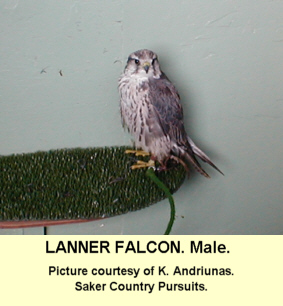
LANNER FALCON.
Falco biarmicus 
‘The Squires Falcon’
IDENTIFICATION. Similar to the Peregrine Falcon the back and tops of wings are slate grey and the head has a narrow black moustache on white cheeks. The lower abdomen, under wing and tail have dark barring on white or light coloured plumage. The chest, on an adult, is white.
Juveniles are brown in colour with brown vertical barring on the chest and a brown moustache and eye line on a cream coloured head.
The main distinguishing features between the Lanner and Peregrine are that the Lanner Falcon is smaller in size, with a longer tail and wings. The top of the head is the best indicator being a rust colour.
DISTRIBUTION. Africa and Southern Europe. The European races, generally found in Italy, with smaller populations in Greece, Turkey and some of the former Soviet countries, are declining due mainly to pesticide poisoning. Preferred habitats are mountainous rocky areas, with wide open spaces such as grassland, savannah and dessert.
FOOD. Generally small to medium sized birds taken in the air and on the ground. Supplemented with small mammals, including bats and the odd rabbit, reptiles and insects. Unusually for birds of prey Lanner Falcons will sometime hunt in pairs (cast).
BREEDING. Late winter - Early summer. 2- 5 eggs laid on cliff or rock face and in trees. Young hatch after 5 weeks, flying just over 6 weeks later.
SIZE. 40-45 cm (16-18in)
WEIGHT. 400g-675g (14oz - 1lb 10oz)
WINGSPAN. 95-115 cm (37.5-45in)
CALL. kek kek kek
FALCONRY.
The Lanner Falcon has, over the past thirty years, become one of the best known falconry birds in this country. The good nature, relative ease of training and intelligence endear them to display falconers. Lure work in particular shows off their aerial skills. Larger than the Kestrel and cheaper than a Peregrine Falcon, the Lanner is probably a better proposition for someone thinking of flying a 'longwing'.
The larger European race of Lanner Falcon tend to be preferred as hunting birds. They can be flown as a 'cast' or used to 'hedge hunt'. The small males, Lannerets, are high mounting and talented fliers, whilst the females are quite capable of taking partridge. however like the Merlin hunting skills seem to wane in the second season. This may in part be down to their intelligence - why hunt for food when muggins the falconer will feed you for nothing. Like most people the Lanner has a dislike of the British weather. Coming from warmer, drier climates rain and wind can hamper the falcons performance.
NB. If you buy one of these raptors it should be fitted with a closed leg ring and have an Article 10 form with it (any queries check with DEFRA).
Falconry marks
![]()
![]()
![]()
![]()